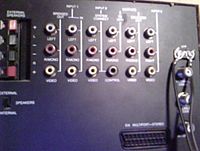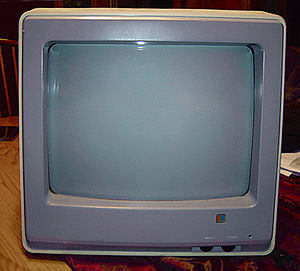- Composite monitor
-
A composite monitor is any analog video display that receives input in the form of an analog composite video signal through a single cable — in contrast to multiple-cable or multiple-wire video sources such as VGA cable. A monitor is different from a conventional TV set because it does not have an internal RF tuner or RF converter that can receive signals from an over-the-air broadcast TV station; however a user can install an external device that emulates a TV tuner (e.g. VCR, cable box, etc.). A video display that is a "monitor-only" is useful for security cameras, some computers, and many other devices.
Contents
Inputs
 Input/output panel of an RCA Dimensia high-end television monitor/TV set of the 1980s
Input/output panel of an RCA Dimensia high-end television monitor/TV set of the 1980s
Composite monitors often have RCA jacks or BNC connectors for video input. Older (1970s) used UHF connectors.
Composite and S-Video are used in PAL and NTSC regions.
Composite monitors can be very high quality, with professional broadcast reference displays costing $10k-$15k (USD) as of the year 2000.
Note that all composite monitors imply the use of a CRT for display, and for color signals anyway, the composite signal must be "decoded" into its three components of red, green and blue to be fed to each gun of the CRT. A critical factor in the quality of this display is the type of "encoding" that is used in the TV camera to combine the signal together and the type of "decoding" that is used in the TV set to separate the signals back to RGB for display.
Comb filters are frequently used to improve the quality of a composite monitor, and devices using the Faroudja decoders are frequently considered the pinnacle of composite displays.
Early innovations of this technology
Originally, these monitors were used for commercial studios. Composite video first saw home use for dubbing tapes on VCRs. Also, one of the first stand-alone composite monitors for home use were on home computers. Notably, IBM PCs with CGA cards, some compatibles, the Apple I, Apple II, Commodore VIC 20/64/128, Atari and other home computers of the 1980s had composite video outputs or composite monitors bundled with/built into the systems; and some computer companies separately sold composite monitors bearing the company nametags (which were intended for use with the aforementioned computers).
Composite video and game consoles
During the same time period, home game consoles chose to stick with channel 3/4 outputs since many people had color televisions without composite video inputs. However, in 1985, the NES was released and was the first game console to feature direct composite outputs. Although the redesigned NES(NES 2) lacked these outputs, the Super NES and nearly all consoles made since have included the direct composite outputs. From the fifth generation systems(such as the Sony Playstation and the Nintendo 64) onward, many consoles used these outputs as the primary means of connecting to the television, requiring a separate adapter for use on televisions lacking composite inputs. As of today, some people still use stand-alone composite monitors with modern game consoles even with the advent of televisions with a tuner and composite inputs combined.
Problems to overcome
Presently, AV devices with advanced technology do not have Channel 3/4 outputs (e.g. DVD players, video game consoles, etc.). One major exception to this is a TiVo DVR. People often use RF modulators to overcome the problem of a TV set not having composite or S-Video inputs. Another method used by some game systems is a built-in RF converter, which eliminates the bulkiness of an RF modulator.
Sometimes, stand-alone composite monitors cannot be used with older-type game systems (e.g. Atari 2600, NES 2, etc.) that have only channel 3/4 outputs for conventional TVs, without modifying the systems themselves. A VCR can often be used to overcome that problem, since most VCRs have TV tuners built in.
These problems could explain why most composite monitors marketed to consumers also have TV-tuner capability. Also, some people have even used more modern computer systems with composite monitors since some people have laptops with S-video out ports which were extended for composite out support; meaning that some composite monitors were recycled for usage with computers. Also, some people treat their laptops as game consoles this way.
Commercial use of composite monitors
- Often, Television studios will use stand-alone composite video monitors. These are usually high-end professional broadcast monitors that are used to view the output of Professional video cameras, VTRs, Character generator, telecines and DDRs. They can also be used when new Video devices are being tested. Most commercial composite monitors have no audio, as the audio system would feed an audio board and/or the speaker system.
- Stand-alone composite monitors are commonly used for video surveillance.
- Many fast food restaurants use composite monitors to display any pending orders for the staff to make.
The monitors used in video surveillance often operate at the same frequencies as composite monitors but are not true composite monitors, as they use black and white graphics so the manufacture cost for the item will go down. Stand-alone composite monitors that are marketed as surveillance monitors are occasionally marketed for home use.
Common features
- Stereo sound
- TV tuner
- Front AV inputs
- S-Video input
- Closed captioning
Examples of non-composites
Examples of non-composite video include
- RGB video (3 signals - Red, Green and Blue - on three wires typically from a computer)
- Component Video (3 signals - such as YUV or Y, B-Y, R-Y) that are used with professional video gear such as a Betacam VTR and some DVD players)
- S-Video (2 signals - which have all of the brightness information on one cable and all of the color information on another; however, almost all monitors with S-Video inputs also feature composite inputs)
- Digital video (many different flavors)
Note: some composite monitors employ usage of these standards. Sometimes "composite monitor" can be a misnomer for s-video only monitors.
See also
Categories:- Television technology
- Film and video technology
- Video hardware
Wikimedia Foundation. 2010.

